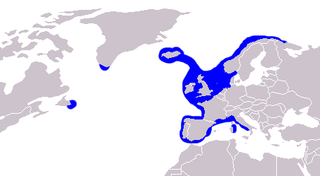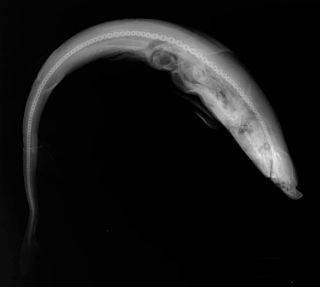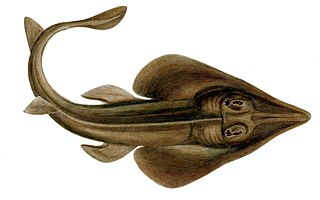
The common ling, also known as the white ling or simply the ling, is a large member of the family Lotidae, a group of cod-like fishes. It resembles the related rocklings, but it is much larger and has a single barbel. This species is unrelated to the pink ling, Genypterus blacodes, from the Southern Hemisphere. The common ling is found in the northern Atlantic, mainly off Europe, and into the Mediterranean Basin. It is an important quarry species for fisheries, especially in the northeastern Atlantic, although some doubts exist as to the sustainability of the fisheries. As an edible species, it is eaten fresh, frozen, or dried, but also preserved in lye, while the roe is a delicacy in Spain.

The white grouper is a species of marine ray-finned fish, a grouper from the subfamily Epinephelinae which is part of the family Serranidae, which also includes the anthias and sea basses. The white grouper is found in the subtropical eastern Atlantic Ocean and the southern Mediterranean Sea.

The little sleeper shark is a small sleeper shark of the family Somniosidae found in the northeast Atlantic, western Mediterranean, and western Pacific around New Zealand, at depths between 200 and 1,000 m. Its length is up to 1.43 m.

The Atlantic weasel shark is a weasel shark of the family Hemigaleidae, found in the eastern Atlantic Ocean. Also known as the little tiger shark, it is the only species of the genus Paragaleus to have been recorded off the western coast of Africa. It is one of four species of small sharks within the carcharhinoid genus Paragaleus, including Paragaleus leucolomatus, Paragaleus tengi, and Paragaleus randalli. It also one of eight species within the weasel shark family, Hemigaleidae. It is currently considered by the International Union for Conservation of Nature (IUCN) as Endangered.

The Portuguese dogfish or Portuguese shark, is a species of sleeper shark of the family Somniosidae. This globally distributed species has been reported down to a depth of 3,675 m (12,057 ft), making it the deepest-living shark known. It inhabits lower continental slopes and abyssal plains, usually staying near the bottom. Stocky and dark brown in color, the Portuguese dogfish can be distinguished from similar-looking species by the small spines in front of its dorsal fins. Its dermal denticles are also unusual, resembling the scales of a bony fish. This species typically reaches 0.9–1 m (3.0–3.3 ft) in length; sharks in the Mediterranean Sea are much smaller and have distinct depth and food preferences.

The angular roughshark is a rough shark of the family Oxynotidae.

The spotted houndshark, Triakis maculata, is a houndshark of the family Triakidae found in tropical waters in the eastern Pacific Ocean off the coast of South America. It usually grows to a length around 180 centimetres (71 in). The reproduction of this houndshark is ovoviviparous, with a litter of 14 pups being found in one female with a birth size of 30 to 40 centimetres. Their diet is believed to consist mainly of crustaceans.

The velvet belly lanternshark is a species of dogfish shark in the family Etmopteridae. One of the most common deepwater sharks in the northeastern Atlantic Ocean, the velvet belly is found from Iceland and Norway to Gabon and South Africa at a depth of 20–2,490 m (66–8,169 ft). A small shark generally no more than 45 cm (18 in) long, the velvet belly is so named because its black underside is abruptly distinct from the brown coloration on the rest of its body. The body of this species is fairly stout, with a moderately long snout and tail, and very small gill slits. Like other lanternsharks, the velvet belly is bioluminescent, with light-emitting photophores forming a species-specific pattern over its flanks and abdomen. The ventral photophores are thought to function in counter-illumination, which camouflages the shark against predators and prey. The bioluminescent flank markings may play a role in intraspecific communication.

The blackmouth catshark is a species of catshark, and part of the family Scyliorhinidae, common in the northeastern Atlantic Ocean from Iceland to Senegal, including the Mediterranean Sea. It is typically found over the continental slope at depths of 150–1,400 m (490–4,590 ft), on or near muddy bottoms. The youngest sharks generally inhabit shallower water than the older juveniles and adults. This slim-bodied species is characterized by the black interior of its mouth, a marbled pattern of pale-edged brownish saddles or blotches along its back and tail, and a prominent saw-toothed crest of enlarged dermal denticles along the upper edge of its caudal fin. It reaches lengths of 50–79 cm (20–31 in), with sharks in the Atlantic growing larger than those in the Mediterranean.

The Australian sawtail catshark is a common species of catshark, and part of the family Scyliorhinidae, endemic to southern Australian waters. It is found on or near the bottom of the outer continental shelf and upper continental slope, at depths of 85 to 823 m. This slim-bodied species is characterized by crests of enlarged dermal denticles along both the dorsal and ventral edges of its caudal fin and caudal peduncle, along with a color pattern of broad, dark saddles outlined in white. It can grow to 61 cm (24 in) in length. The Australian sawtail catshark feeds mainly on fishes, crustaceans, and cephalopods. Females are oviparous and lay eggs enclosed by capsules. This species is often caught incidentally by commercial bottom trawl fisheries, but is not significantly threatened by fishing activity. Thus, it has been assessed as of Least Concern by the International Union for Conservation of Nature (IUCN).

The sawback angelshark is an angelshark of the family Squatinidae It is one of rarest species of sharks known to date, and one of the three species of angelsharks that inhabits the Mediterranean. The Sawback angelshark lives in sandy and muddy bottoms of the ocean at depths of 30-500m.

Mullus barbatus is a species of goatfish found in the Mediterranean Sea, Sea of Marmara, the Black Sea and the eastern North Atlantic Ocean, where its range extends from Scandinavia to Senegal. They are fished, mostly by trawling, with the flesh being well regarded. The International Union for Conservation of Nature has assessed their conservation status as being of "least concern".

The thornback guitarfish is a species of ray in the family Platyrhinidae, and the only member of its genus. Despite its name and appearance, it is more closely related to electric rays than to true guitarfishes of the family Rhinobatidae. This species ranges from Tomales Bay to the Gulf of California, generally in inshore waters no deeper than 6 m (20 ft). It can be found on or buried in sand or mud, or in and near kelp beds. Reaching 91 cm (36 in) in length, the thornback guitarfish has a heart-shaped pectoral fin disc and a long, robust tail bearing two posteriorly positioned dorsal fins and a well-developed caudal fin. The most distinctive traits of this plain-colored ray are the three parallel rows of large, hooked thorns that start from the middle of the back and run onto the tail.

The Brazilian guitarfish is a species of fish in the family Rhinobatidae. It is endemic to Brazil, where its natural habitat is coastal waters on the continental shelf. This fish is viviparous and has a long gestation period, concluding with the birth of live pups in February. At this time the fish are subject to intense fishing activity but catches have been dwindling in recent years as a result of overfishing. Because so few breeding-size fish remain, the International Union for Conservation of Nature has assessed the fish's conservation status as being "critically endangered".

The red porgy, or common seabream, is a species of marine ray-finned fish in the family Sparidae. It is found in shallow waters on either side of the Atlantic Ocean, being present on the western coast of Europe and the Mediterranean Sea as well as the eastern coasts of North and South America and the Caribbean Sea. It feeds on or near the seabed and most individuals start life as females and later change sex to males.

The spiny butterfly ray or giant butterfly ray is a species of butterfly ray, family Gymnuridae, native to the shallow coastal waters of the Atlantic Ocean. A large ray that can measure over 2 m across, it may be distinguished from the sympatric smooth butterfly ray by the spine at the base of its tail and by a small tentacular structure on the margin of each spiracle. Slow-reproducing and valued for its meat, in recent decades its population has experienced a decline of over 30%, and it has become Critically Endangered in certain parts of its range.

The false scad, also known as the spotfin scad, ten-finned horse mackerel and yellow horse mackerel, is a species of medium-sized marine fish classified in the jack family Carangidae. The false scad is distributed throughout the tropical and temperate waters of the eastern Atlantic Ocean from Namibia in the south to Spain and throughout most of the Mediterranean in the north. The species has an atypical body form compared to other species of Caranx, and can be distinguished from these on its elongate 'scad-like' body shape alone. Distinguishing the species from members of Decapterus and Trachurus is more difficult, requiring detailed anatomical analysis. The false scad is known to grow to a length of 60 cm and a weight of 1 kg. The species lives both pelagically and demersally in continental shelf waters, ranging from depths of 15 to 200 m. It is a predatory fish, taking small fishes, crustaceans including euphausiids and shrimps, and cephalopods as its main prey, with significant dietary shifts as it ages. The false scad reaches sexual maturity at 2 years of age, with spawning occurring between April and July in shallow inshore waters, where the juveniles remain. The species is of major importance to fisheries throughout its range, but particularly from Morocco to Senegal, with annual catches ranging from 500 to 19000 t. The species is caught using trawls, seine nets and gill nets and sold fresh, frozen or salted.

The European pilchard is a species of ray-finned fish in the monotypic genus Sardina. The young of the species are among the many fish that are sometimes called sardines. This common species is found in the northeast Atlantic, the Mediterranean, and the Black Sea at depths of 10–100 m (33–328 ft). It reaches up to 27.5 cm (10.8 in) in length and mostly feeds on planktonic crustaceans. This schooling species is a batch spawner where each female lays 50,000–60,000 eggs.

The common guitarfish is a species of cartilaginous fish in the family Rhinobatidae. It is native to the eastern Atlantic Ocean and the Mediterranean Sea. It is a bottom-dwelling fish feeding on crustaceans, other invertebrates and fish. The females give birth to live young. Its lifestyle makes it vulnerable to trawling and other fishing methods, populations seem to be declining and it has disappeared from parts of its range.

Glaucostegus, also known as giant guitarfishes, is a genus of large Indo-Pacific rays, with a single species, Glaucostegus cemiculus, in the East Atlantic, and Mediterranean. They were formerly classified in the family Rhinobatidae but are now recognized as a distinct family, Glaucostegidae.





















